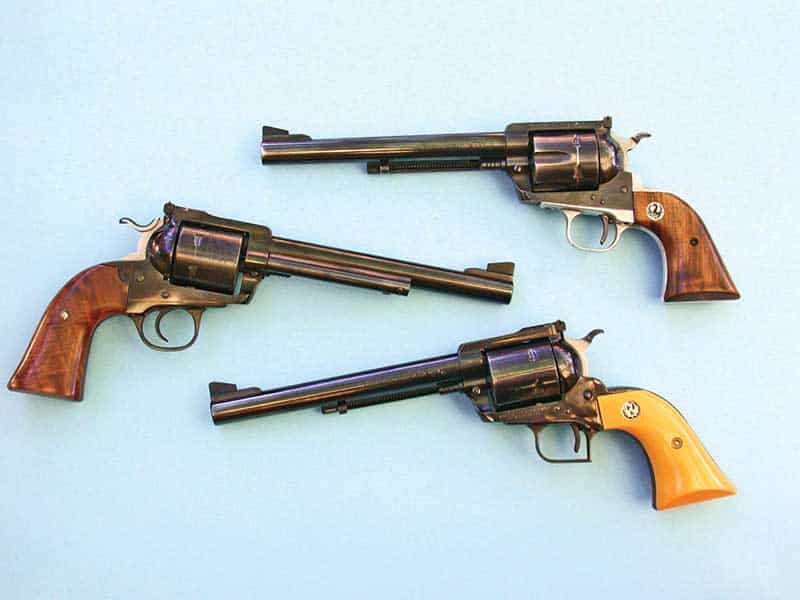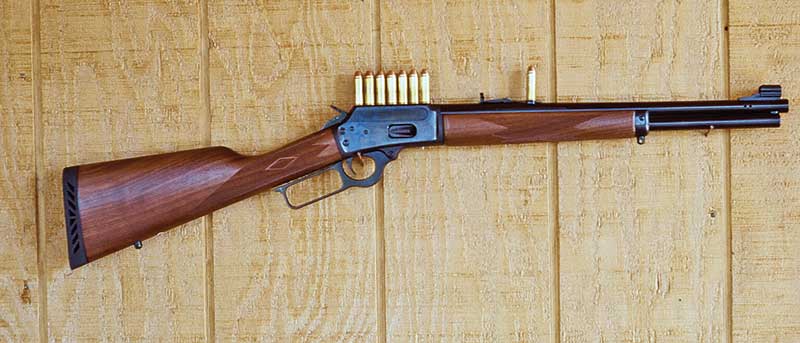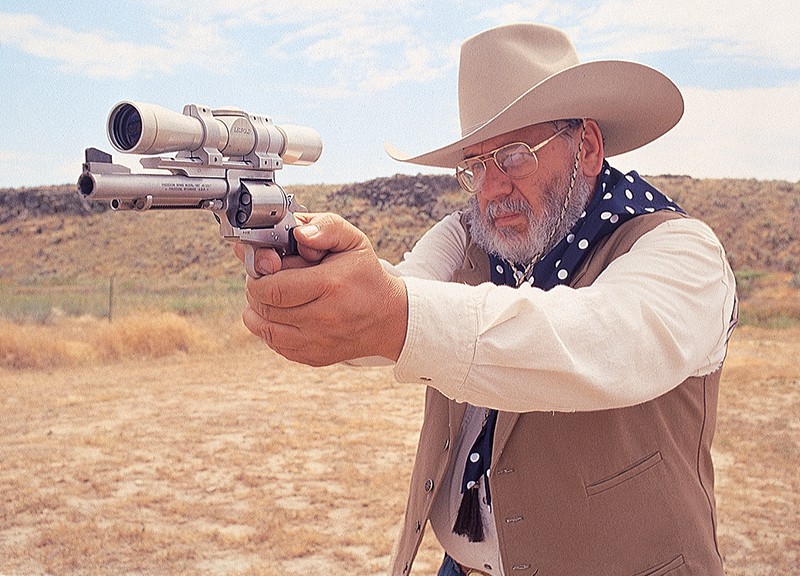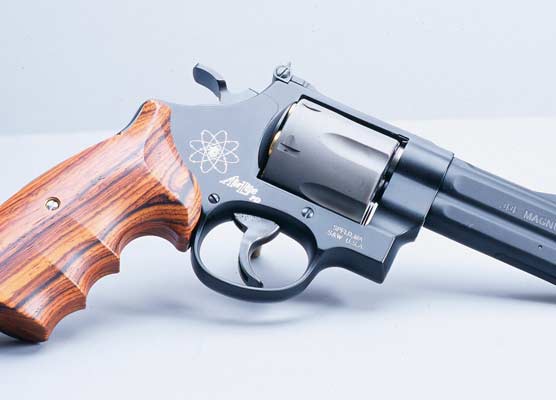Mythbusting The Magnum
Many "Stories" Abound.
One thing I have always collected/accumulated has been information. I was a teenager when most of the present day gun magazines arrived in the late 1950s. Suddenly there was information everywhere and I started clipping articles. When I started writing articles myself I had more information to add to the stockpile. It didn’t take long for a file cabinet to be overflowing so I switched to large 3-ring binders with plastic sheets to receive the pages. Currently, I have 25′ of book shelving reserved for nothing but information of my own or other writers. This includes articles as well as thousands of personally fired reloads accumulated over the 4-plus decades. Research is very important to me.
We are living in what is called the information age, however often much of that information is actually misinformation. The .44 Magnum, both sixguns and cartridge, has been with us now for nearly 60 years. There is much good information out there in both the printed page and on the Internet, however there are also a lot of mistakes and myths perpetuated. The wise seeker learns, or at least should learn which are dependable resources and which are not. Internet forums are one of the worst places to find reliable information, however one of the best sources of wrong information. It is amazing to me to see the stuff that is disseminated and gains a wide audience of believers. After all, once something is printed on a page or on the screen for many people it becomes gospel. Let the reader beware!
Way back in the dark ages, before gun magazines, I depended upon Elmer Keith in the American Rifleman and Pete Kuhloff and Lucian Cary of Argosy and True magazines respectively to provide much desired information. I learned very early even this information was not always totally dependable. None of us are infallible and all of us write things at times that don’t prove to be all that dependable.
.44 Magnum
With the arrival of the .44 Magnum from Smith & Wesson, Cary spoke of the soon-to-arrive Ruger .44 Magnum Blackhawk, which he had yet to see, with these words: “This gun will be considerably lighter than the Smith & Wesson and consequently will recoil even more. But this revolver will have a grip copied from that of the Colt Single Action—a grip that is easy on the hand.” Cary, of course, was writing before the fact of ever shooting a .44 Magnum Ruger Blackhawk and was he wrong about the grip being easy on the hand! His experience had been with nothing larger than a .45 Colt, however when the Colt-style single-action grip frame is mated up with the .44 Magnum cartridge it is definitely not easy on the hand. I didn’t learn this until I bought the .44 Ruger. It took a lot of learning for me to be able handle the then-new Magnum cartridge with that grip frame.
Long before the .44 Magnum arrived, Elmer Keith had been using the bullet he designed for his .44 Special. That bullet was the Lyman/Ideal 429421 in use for nearly 30 years before the .44 Magnum arrived, and when the new Magnum came about Elmer simply switched .44s and used the same bullet. I just found this myth about the Keith bullet this month. “Remember, Keith was doing his work in .44 Special cases, so the nose length on his original design was meant to get bullet mass out of the case, up to the length restriction of the S&W cylinder. If you find an original long-nose mold and load those bullets in new .44 Magnum cases you will probably have a combination too long for your cylinder. That’s why you see newer-design molds with shorter noses.”
What? Keith made the switch to .44 Magnum cases with his original bullet with no problem. I have been casting Keith bullets from original molds for over 50 years. Not only do I have his original 429421, I also have examples of Keith bullets from H&G, NEI, and RCBS. I have yet to find one single factory produced .44 Magnum sixgun with the cylinder too short to accept the original Keith bullet loaded properly which means crimped in the crimping groove.
Bullet Myths
To give the writer of this myth the benefit of the doubt I am going to guess he just mis-remembered. What he says is not true about the .44 Keith bullet but rather the .45 Keith bullet which is 454424. Early on, I found there were some .45 Colt Single actions, which had cylinders just short enough that this bullet crimped in the crimping groove of the case protruded from the front of the cylinder enough to keep it from rotating. Years ago, Lyman dropped this design in favor of 452424 which is slightly shorter and the RCBS 45-255KT and 45-270SAA both have noses slightly shorter than the original 454424. Call his myth a brain fade or a mis-remembering both of which I have been guilty of in the past, and probably will be in the future. It is simply a fact of life.
Also, this month I was reading an excellent article on American carbines and I ran across this misstep: “One inexplicable aspect of the Marauder was that it was chambered in .30-30 and .35 Remington, at the same time as Marlin decided to chamber the longer-barreled 336T in .44 Magnum. Had the Marauder been offered in the shorter cartridge, it might have caught on—and imagine the demand for it today for cowboy action!” The Marauder was the Marlin lever action, straight stocked, saddle carbine with a 16-1/4″ barrel, one the handiest leverguns ever offered.
There are couple of mistakes in this writer’s take on the situation. Although Marlin never offered a short-barreled .44 Magnum that was actually called the Marauder, they did offer two versions of the 16-1/4″ .44 Magnum. One was called the Trapper and the other the Prospector. I have one of each and they are dandy little carbines. As far as demand by cowboy action shooters there would be absolutely none as the sport requires a lever gun which will hold 10 rounds in the magazine tube and for the .44 Magnum this requires a 20″ barrel.
Perusing through two separate Internet forums recently, I found some most interesting stuff about the .44 Magnum, none of which, of course, is true. Here is one: “Story has it when the Ruger folks first found the .44 Magnum they made a .44 Magnum Blackhawk and loaded it up and test-fired it and every screw on the test gun came loose. These are .44 Magnum Blackhawks but Ruger built the Super Blackhawk for a good reason. It was made to take the pounding loads.” And then on another site I found this: “If so then those few .44 Magnums which escaped the factory before the cartridge was permanently relegated to the Super Blackhawk frame and cylinder must be dangerous?”
Even on the Internet finding so much misinformation in so few words is amazing!
Here are the facts: When Bill Ruger found out about the .44 Magnum he had three prototypes made up using the smaller-framed .357 Blackhawk. Elmer Keith told him the frame and cylinder were too small for the new Magnum, however he would like to have the shorter barreled version to use as a .44 Special. This was at an NRA Show and when Keith went to pick up his sixgun it had already been packed to return to the factory.
On further testing, Keith proved to be right and one of the prototypes blew, the other two were destroyed, and Ruger went to a larger frame and cylinder which became the .44 Magnum Blackhawk. This was 1956. The Blackhawk would remain in production until 1963 with over 25,000 being made. None of these “escaped” the factory. The Super Blackhawk came along in 1959 for those who complained they needed more recoil-reducing weight than the standard .44 Blackhawk afforded. Both guns are built on the same exact sized frame and cylinder and the .44 Blackhawk was produced alongside the .44 Super Blackhawk for several years.
As far as “every” screw loosening, I doubt that very much. Single Actions from the 1873 Colt forward all are prone to loosen screws. There are several remedies which have been tried including nylon washers under the screw heads, nylon inserts in the screw bodies, and the ultimate Loc-titing the screws in place. I learned at least 50 years ago to always carry a proper fitting small screwdriver with me and periodically check the screws. Even the excellent Freedom Arms sixguns are prone to screws loosening and need to be checked periodically.
It pays all of us to read with a discerning eye and mind and be very careful what we accept as gospel. The more we know, the harder we are to fool.








